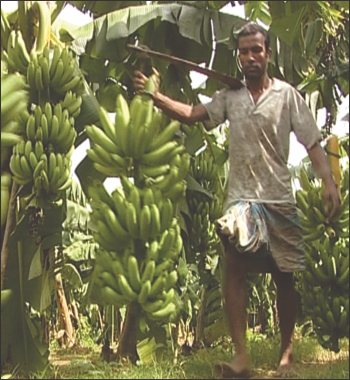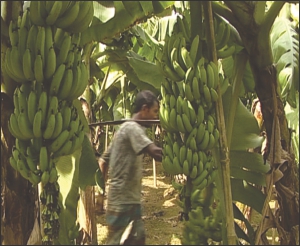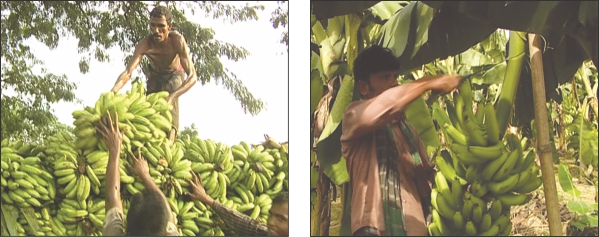Farmers’s Voice
Clusters of Hope
The entire northern region of Bangladesh was once haunted by scarcity and poverty. During the last few years, farmers concentrated on profitable crops with minimum costs. Starting from Tangail, right down to the end of the northern part, Kurigram, Nilphamari and Panchgarh, banana farming has increased overwhelmingly. It's a long-term farming method – but because the low cost of production, farmers are choosing banana farming to gradually eradicate poverty..
.................................................................................................
Shykh Seraj
 Gaibandha district is the leading banana cultivating region of Bangladesh. Every year banana farming area is increasing in the three upazilas of Gobindaganj, Palashbari and Sadullapur. The marginal farmers, as well as the promising agro-entrepreneurs are now getting involved into banana farming. It is the main cash crop for the farmers of this region at the moment. Gaibandha district is the leading banana cultivating region of Bangladesh. Every year banana farming area is increasing in the three upazilas of Gobindaganj, Palashbari and Sadullapur. The marginal farmers, as well as the promising agro-entrepreneurs are now getting involved into banana farming. It is the main cash crop for the farmers of this region at the moment.
In 2011, on 1100 hectares of land, banana was farmed. In 2012, the farming area has increased up to 1250 hectares.
On 8325 bigha land in Gaibandha district, banana varieties of, Sagar and Jahaji, Chanpa on 1200 hectares, and Malbhogh and Sabri on 2100 bighas are farmed. Here, at the barinds area of the two upazilas, Gobindaganj and Palashbari, banana is farmed on 7650 bigha land. Per bigha banana farming cost is around 20,000 taka and farmers earn around 60,000 taka. Banana is more profitable than rice and jute in this region.
Farmers don't have to go far to get information on banana farming because the farming has increased hugely here. If one look at the Gaibandha-Dhaka-Rangpur highway they would easily understand it. Almost throughout the year, on this highway, on 32 kilometres road, two days a week, farmers gather at the roadside haat (market).
The haat-days are held in different days of the week in different upazilas. In Palashbari, the haat is held on every Wednesdays and Saturdays; in Gobindaganj, Sundays and Thursdays; in Fashitola, every Fridays and Mondays. At each market, around sixty to hundred trucks of banana are sold. The wholesalers take bananas to the entire country, including Dhaka, Comilla and Chittagong districts.
The wholesalers are the real authority of the haat. Whatever farmers earn from the market, they consider it as their profit.
 'We don't get much', said a farmer. 'We don't get much', said a farmer.
'The wholesalers take our profit away and that is how it has been going on so far', the farmer added.
Commercial labour system has developed here with the expansion of the banana markets. Porters, rickshaw-van pullers and many others work at the market.
The wholesalers' calculation is pretty extended. They believe the market price is still in favour of the farmers.
“We have to bear many more costs after buying bananas from them”, claimed a wholesaler.
Both farmers and wholesalers say that banana market is not going good at the moment. During the month of Ramadhan, they get real good price.
Though, locally banana farming has increased but farmers don't have a nearby proper market infrastructure. As there is no such favourable market infrastructure, that is why farmers can't make the profit they like.

Bananas travel to the capital markets and are being sold. Apparently, it is assumed that the way bananas are sent to the market, there is no way that anyone can use harmful chemicals. Most of the wholesalers say it ripens naturally. Some say, they use a 'heat' method for ripening.
And, some boldly confessed the truth that the bananas are ripened through unhealthy ways.
 Long back, 'Hridoye Mati O Manush' aired an episode on promising banana production at Jhenaidah's Kaliganj upazila. There, the farmers used a century-old, natural banana-ripening heritage. They stacked the bananas in a clay-room and put a stove on inside the room so that the bananas ripened fast without chemicals. This ripening was healthy. Farmers from different regions can follow this method. Long back, 'Hridoye Mati O Manush' aired an episode on promising banana production at Jhenaidah's Kaliganj upazila. There, the farmers used a century-old, natural banana-ripening heritage. They stacked the bananas in a clay-room and put a stove on inside the room so that the bananas ripened fast without chemicals. This ripening was healthy. Farmers from different regions can follow this method.
The reality is that, very few use the ancient and the 'heat' method to ripen banana. From farmers to the wholesalers and then to the Dhaka based big traders (Mahajan) - in this cycle, the purity of the banana decreases abruptly. Farmers are not even aware of this situation.
Banana farming extension at the northern part is a very optimistic sign. But, the main concern is to ensure healthy bananas for people across Bangladesh. Besides, the banana market, stretched on 32 KM highway in Gaibandha district. If farmers don't get a permanent banana market with proper infrastructure right away, farmers would become frustrated once again, because of the existing intermediary influence. Moreover, to ensure uninterrupted vehicle movement on the highway, this banana market should be taken at a safer place and government and local administration have a major role to play here.

Copyright
(R) thedailystar.net 2012 |

 G
G 'We don't get much', said a farmer.
'We don't get much', said a farmer. 
 Long back, 'Hridoye Mati O Manush' aired an episode on promising banana production at Jhenaidah's Kaliganj upazila. There, the farmers used a century-old, natural banana-ripening heritage. They stacked the bananas in a clay-room and put a stove on inside the room so that the bananas ripened fast without chemicals. This ripening was healthy. Farmers from different regions can follow this method.
Long back, 'Hridoye Mati O Manush' aired an episode on promising banana production at Jhenaidah's Kaliganj upazila. There, the farmers used a century-old, natural banana-ripening heritage. They stacked the bananas in a clay-room and put a stove on inside the room so that the bananas ripened fast without chemicals. This ripening was healthy. Farmers from different regions can follow this method. 